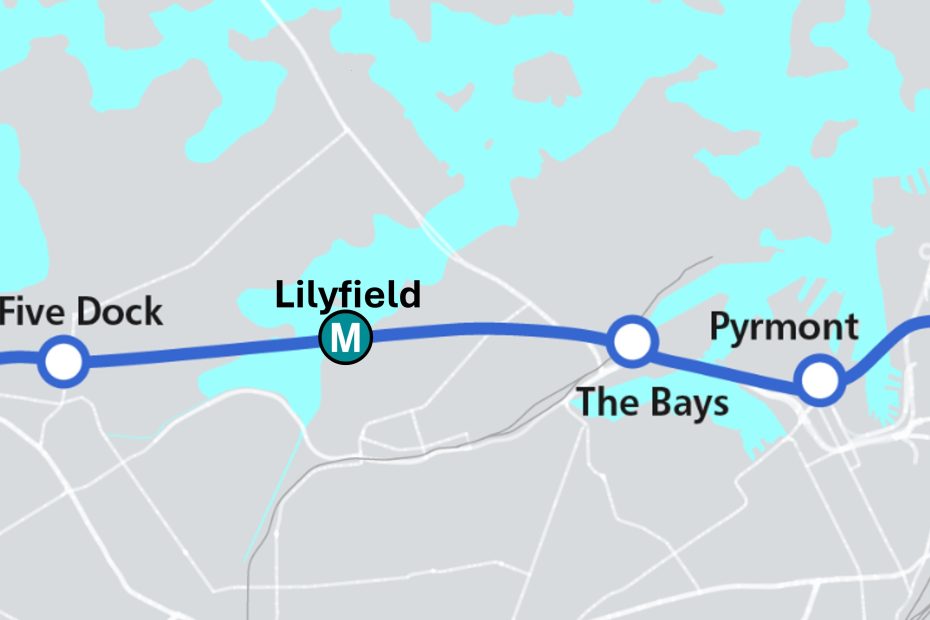And Callan Park Deserves to Be Connected to the Whole City
Lilyfield is not a blank space on the map — it is a thriving Inner West suburb where people move, gather and live active lives. From early-morning cyclists along the Bay Run to weekend games around Leichhardt Oval and art workshops scattered throughout Callan Park, this neighbourhood pulses with community energy. Light rail lines run down its spine along Lilyfield Road, frequent buses connect it to Rozelle, Balmain and the city, and people walk and ride more here than in most parts of Sydney. Yet the Metro West line — the city’s next great public transport backbone — is currently set to tunnel directly beneath Lilyfield and Callan Park without stopping.
This would create one of the longest station gaps on the entire alignment: 4.5 kilometres between Five Dock and The Bays. And that gap doesn’t run through warehouses or open water. It passes under thousands of people, major sporting and recreation destinations, and one of Sydney’s most significant public parks. A Lilyfield station would immediately reinforce the behaviour the Inner West already demonstrates so well: choosing transit, choosing shorter trips, choosing active streets over car dependency. With a metro station, residents could reach Parramatta or the CBD in minutes, without having to squeeze onto crowded buses or cycle uphill to the nearest rail connection. The suburb’s existing light rail and bus corridors would become genuine multimodal interchanges, giving people options that are fast, reliable and climate-friendly.
Crucially, a Lilyfield station would unlock Callan Park for the entire city. Today the park serves a loyal local community, but its regional role is limited by access. For most people in Greater Sydney, visiting Callan Park requires a long walk from the light rail or a trip by car — and the latter compromises the very peace and open space people come to enjoy. A metro entrance near Balmain Road or the western precinct would allow families from anywhere to step off a metro and walk straight into a waterfront parkland rich in heritage, sport and culture. If we talk about equitable access to green space, this is what it looks like in practice.
There is also a clear opportunity here to provide more housing where it actually belongs — near jobs, education and transit. North Lilyfield, between City West Link and Iron Cove, is well suited for medium-scale growth: flat streets, strong existing services, and rapid access to hospitals, universities and employment centres in both directions. This is housing that shortens commutes rather than lengthening them, housing that lets nurses and hospitality staff live near late-night shifts, housing that supports downsizers and young families who want to stay in their community rather than move further away. The areas south of City West Link and the established heritage streets would remain protected.
Naturally, there are concerns that a station could open the door to major development inside Callan Park. That is a fair question — and precisely why the proposal needs to be clear and limited from the outset. The only sites being considered are those already modified: existing sports fields and a small number of low-heritage buildings in the western section. In exchange for allowing a compact metro entrance and carefully planned transit-oriented development outside the significant landscaped core, the remainder of Callan Park would be placed under permanent protection. Far from weakening its future, this approach would provide stable, ongoing funding for maintenance, accessibility upgrades and the restoration of heritage structures currently at risk through neglect.
If Metro West bypasses Lilyfield, Sydney will almost certainly regret it. We are already dealing with the mistake of ending the Eastern Suburbs Railway short of Bondi Beach — a decision that has constrained transport and triggered decades of overcrowded buses. The parallel here is impossible to ignore. Metro West would be serving a neighbourhood with strong ridership demand, a regionally important park, and a growing role in the life of the city. To tunnel beneath Lilyfield without stopping would be perplexing now — and unforgivable later.
The action required today is not full station construction. It is simply preserving the option before the project passes the point where change becomes impossible. The Greater Sydney Parklands Trust and the NSW Government must reserve appropriate land for a future station entrance within the Callan Park Plan of Management, establish clear planning controls for any supporting development, and lock in protections for everything that makes Callan Park special. Those steps cost very little — but they prevent the door from closing permanently.
The metro tunnel is coming to Lilyfield either way. The only question is whether Lilyfield will be allowed to benefit from it. With thoughtful and accountable planning now, Lilyfield gains the metro access it deserves, and Callan Park gains a future where its beauty, history and community value are supported by the entire city. This is a rare chance to make the metro work harder, make the park more accessible, and make the Inner West fairer — all with one decision. Let’s not let the metro pass Lilyfield by.
